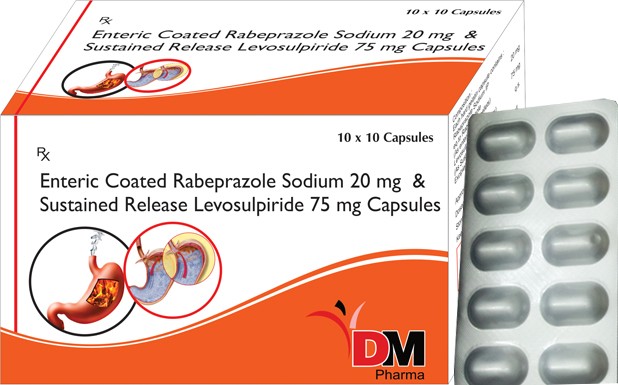Capsule Presentation
Each hard gelatin capsule contains:Levosulpiride 75 mg
(SR Pellets)
Rabeprazole Sodium 20 mg
(EC Pellets)
This is a combination of two medicines:Levosulpiride and Rabeprazole. Levosulpiride is a prokinetic which works by increasing the release of acetylcholine (a chemical messenger). This increases the movement of stomach and intestines, and prevents reflux (acid going up to the food pipe). Rabeprazole is a proton pump inhibitor (PPI). It works by reducing the amount of acid in the stomach which helps in the relief of acid-related indigestion and ulcers.
Indication
- Gastroesophageal reflux disease (acid reflux)
- Intestinal ulcers
- Irritable bowel syndrome
- Bacterial Infection Due to Helicobacter Pylori (H. Pylori)
Mechanism of Action
Levosulpride is a dopamine D2-receptor antagonist.Levosulpiride is more selective and acts primarily as a dopamine D2 antagonist. Sulpiride appears to lack effects on norepinephrine, acetylcholine, serotonin, histamine, or gamma-aminobutyric acid (GABA) receptors. It is absorbed slowly from GIT with only25-30% bioavailability.Rabeprazole is an antiulcer drug in the class of proton pump inhibitors.It is a prodrug - in the acid environment of the parietal cells it turns into active sulphenamide form. Rabeprazole inhibits the H+, K+ATPase of the coating gastric cells and dose-dependent oppresses basal and stimulated gastric acid secretion. Rabeprazole blocks the final step of gastric acid secretion. In gastric parietal cells, rabeprazole is protonated, accumulates, and is transformed to an active sulfenamide. When administered orally, the bioavailability is only 52% and 96.3% of the drug is bound to plasma protein. It is metabolised in liver and about 90% of the drug is excreted in urine. The half-life of rabeprazole is 1-2 hours.
Side Effects
- Constipation
- Diarrhoea
- Pain in the abdomen (stomach area)
- Gas
- Amenorrhea
Know About new DCGI Approved Products
Copyright © by Alaina Pharma. All rights reserved.
Created by Alaina Pharma
